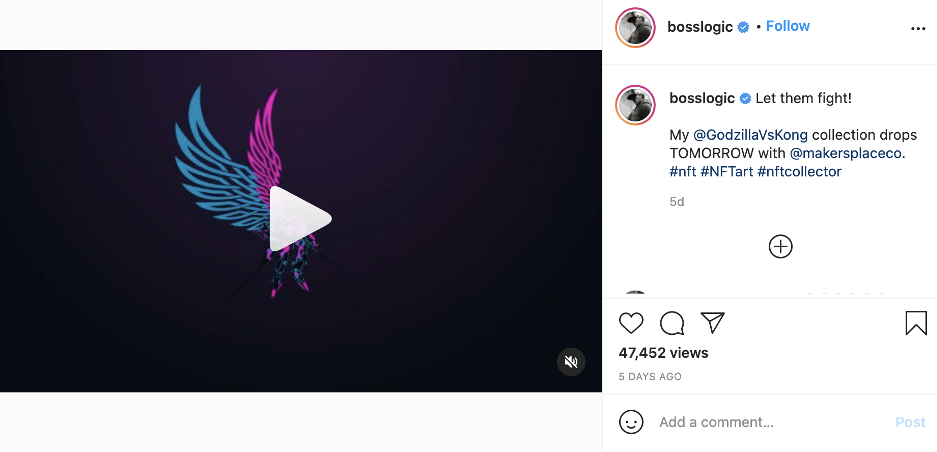It’s crazy to think that someone would be willing to fork out a whopping US$5.8 million for an animated video of a flying cat, and that is exactly what went down in recent months.
Did we mention that this video has been available for free for the past decade?
The conversation about NFT art has been rising, and we’re certain that they are here to stay.
What exactly are NFTs?
Starting with the basics, Non-Fungible Tokens (NFTs) are one-of-a-kind cryptographic, blockchain-based assets that cannot be exchanged at equivalency for something else.
This is unlike bitcoins which are fungible – trade one for another, and you’ll have the exact same thing.
These months have seen notable figures like Grimes, Lindsay Lohan and Logan Paul selling millions worth of NFTs. Even Twitter CEO Jack Dorsey joined in on the fun, selling his first tweet as an NFT for US$2.9 million.
It’s radical that NFTs can be tagged to almost anything and everything digital.
A question that’s sure to float around: “Can’t I just download them for free on the internet?”
While the answer is “Yes, you can”, NFTs give you an extra edge – ownership of the work. If we’re looking at it in terms of physical artwork, anyone and everyone can buy a print of the Mona Lisa, but ultimately there will only be one person who owns the original painting.
How can brands use NFTs?
The mainstream attention that NFTs are gaining have opened up new paths for brands to engage in brand storytelling and consumer interaction. With the versatility of NFTs, the possibilities are plenty! Here are some we noticed:
1. New Modes of Monetization for Digital Media
NFTs are a game-changer in that they upend the distribution and monetisation of digital media.
Going beyond the tagged price of the digital asset and number of copies sold, the value of the work is determined by the number of copycat versions they inspire, similar to that of TikTok. This is made possible with how digital assets are easily remixable or memed. As more versions are created, the more popular and valuable the original video becomes.
This holds interesting potential as it enables a collaborative environment for user-generated content in a way that makes branded content both remixable and also non-fungible. With NFTs, brands can verify themselves as rightful owners of their digital content, affording them the freedom to create without worry of undesirable, altered versions being inaccurately attributed to their name.
2. Experiential Collectibles
NFTs make digital collectables possible. Even without an artist collaboration, brands can still utilise NFTs to engage with their audience and level up their marketing campaigns.
This giveaway example sees JEN by Shangri-La featuring an NFT artwork of Bruce Lee, linking the iconic personality to their brand ethos through his embodiment of the “New Asia” spirit that continually challenges stereotyping perceptions of Asian cultures and the martial arts.

While this artwork was not made in collaboration with the hotel chain, we see how the NFT helped drive brand awareness and engagement for JEN. The giveaway even got them a press mention on MARKETING-INTERACTIVE, being the first of its kind in the region.
3. Custom Brand Collaborations
In collaboration with artists, NFT-enabled brand artwork and digital collectables can help to generate buzz and engagement as well as draw attention to brands.
In this example, we see major motion studio Legendary Entertainment bring their energy into the world of blockchain in their exclusive ‘Godzilla vs. Kong’ NFT collection, created in collaboration with artists BossLogic and Terra Virtua Ltd.
Released on the same day as the film, it couldn’t have been timed better to get fans of the franchise and collectors talking. Placing branded collectables in the hands of your consumers also helps keep your brand top-of-mind and foster brand loyalty.

4. One-off Digital Experiences and Products
Experiential collectables can be taken further with limited edition drops by brands for exclusive use in games or an AR experience made available only through the purchase of an NFT.
According to VentureBeat.com, CEO of Machine Zone, Gabe Leydon talks of the revolutionary role that NFTs play in the gaming industry.
“People spend a lot of money in games. When they quit a game, that money is gone. Your investment is gone. It doesn’t mean anything… So if people are willing to spend that kind of money in something where if they stopped logging in, it has no value. What happens when, if they stop logging in, they sell what they bought. It will change the whole nature of video games. It won’t be spending anymore. It will be investing. So it totally changes everything.”
Beyond a temporary possession of something virtual, these exclusive in-game NFT items then become an expanding asset for users in the long term.
5. Owning a Moment
Iconic moments during real-life events could be captured and embedded as a digital collectable or limited edition artwork with NFTs. And in a digital world where copies are easily created and distributed, NFTs make it possible to create digital scarcity, increasing the value of these items.
One example is the NBA Top Shot which sees trading cards embedded with video highlights, allowing consumers to own “the best moments from NBA history” – a move that has led them to sell over US$80 million worth of clips.

NFTs are lighting up across the world, moving beyond art and entertainment to hospitality and sports, allowing brands to connect and engage with their audiences like never before. But like with any emerging technology, proper strategic planning is always important before diving in! If you’re looking to explore what NFTs can do for your brand, we’d love to help! Drop us a note today.
